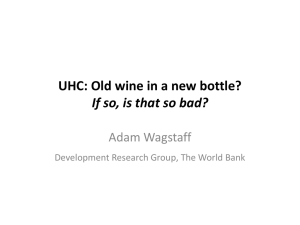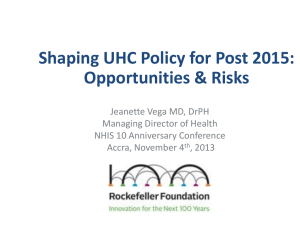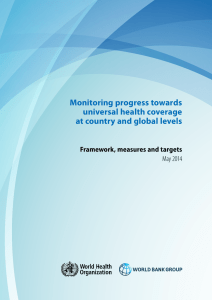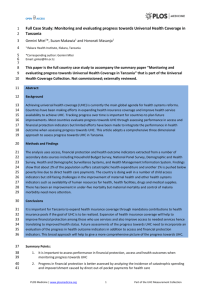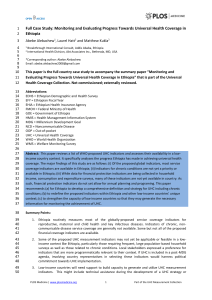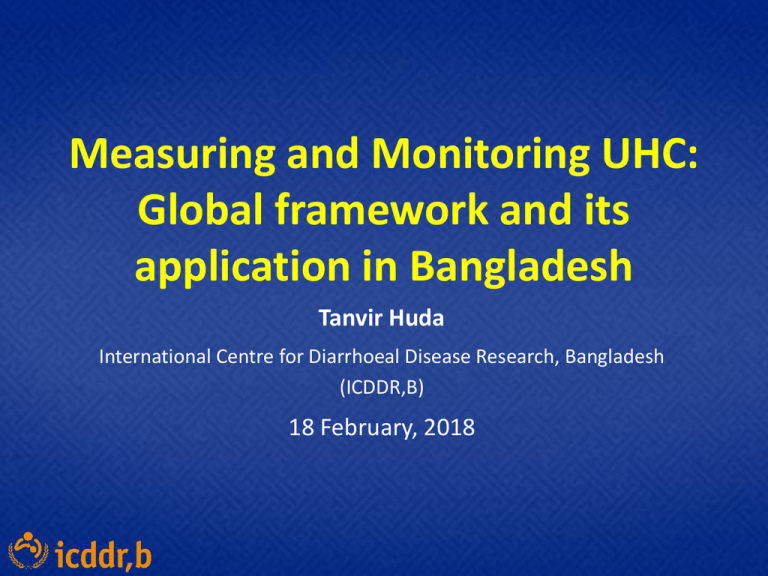
Measuring and Monitoring UHC:
Global framework and its
application in Bangladesh
Tanvir Huda
International Centre for Diarrhoeal Disease Research, Bangladesh
(ICDDR,B)
18 February, 2018
Universal Health Coverage
Financial
Protection:
Protect
population
s against
impoverish
ment due
to illnesses
since most
of health
care is paid
for out-ofpocket
Population Coverage: Expand coverage
to allow equal access for all persons
2
Service Coverage: Define a set of
essential health care services
based on the priority health needs
for each country
Guiding Principal for UHC M&E
framework
• Should measure essential health services
coverage and financial protection coverage
• Should encompass the full population
inclusive of all ages and gender
• Should capture all levels of the health system
• Should be disaggregated by socioeconomic
strata
Result framework for UHC
Coverage of what interventions for health needs
M&E framework and practices for
current health sector program
• Bangladesh is currently in its third sector-wide
approach
– A Results Framework and 32 OP-level indicator
lists are in place to monitor the implementation of
the sector plan
– Program Management and Monitoring Unit along
with Planning wing of MoHFW is responsible for
measuring the progress of implementation of
HPNSDP
Result framework for HPNSDP
Result framework for HPNSDP
(Output)
• At the output level, current RF focuses mainly
on service utilization provided at the primary
level
– No indicators to measure service utilization and
quality of service at other levels of care
(Secondary and tertiary level)
– With introduction of prepayment schemes we
expect service utilization to increase at all levels.
Result framework for HPNSDP
(Outcome)
• At the outcome level HPNSDP RF suggest a
strong preference for measuring primary care
service coverage ( MNCH, Nutrition)
– No indicators to measure the coverage of
secondary or tertiary level health care services, or
services directed towards non-communicable
diseases.
– No indicators to measure coverage of financial risk
protection
Result framework for HPNSDP
(Impact)
• All impact level indicators are directed
towards improved health status in maternal
child health nutrition and family planning,
except for one on HIV.
– No indicator on the health status of the adult
population or financial wellbeing of the household
Coverage Indicators (FP, Delivery, Maternal
Health, Under-5 Illness, TB, HIV, Malaria,
NTD)..current RF and OP indicators
Family Planning
Promotion Treatment
/Prevention
6
n/a
Equity
1
Delivery and Maternal Health
3
7
2
Under five illness
-
6
-
Immunization
3
n/a
-
Malaria
-
1
Neglected Tropical Disease
-
1
-
HIV/TB
-
1
-
Coverage Indicators (Chronic disease, disease
requiring higher level intervention, Cancer, mental
health, injury, occupational health, environmental
health, injury, rehabilitation, palliation)
Chronic disease, disease requiring
higher level intervention, Cancer
Mental health
Injury
Occupational Health
Environmental Health
Promotion Treatment Equity
Prevention
2
1
1
1
-
-
-
Result framework for UHC
• Current RF is suitable for measuring the UHC
provided few indicators are added on the
missing domains
• Coverage of NCD, Injury, occupational,
environment services
• Coverage of priority services provided at
secondary and tertiary level,
• Overall Service quality
• Coverage of Financial protection
Additional Indicators for
UHC..examples
At output level
– Service readiness
• Percent of facilities, by type, has facilities to screen a)
hypertension and b) diabetes for adult clients
• Percent of facilities, by type, has facilities to screen
cervical cancer / or undertake mamogram
– Service quality and safety
• % of deliveries in facilities ending in perinatal death
– Emergency readiness
• Percent of private hospitals/clinic having functional
Emergency Ward
Additional Indicators examples..cont
• Outcome level
– Coverage of Intervention targeting Injury
• Care within 30 mins. of traffic and non-traffic
accident
– Coverage of Intervention targeting Chronic care
• Proportion of Hypertension and diabetic cases
taking medication and disease under control
– Coverage of secondary and tertiary level
Intervention
• % of cataract cases under gone surgery
• % of angina, arthritis, asthma,depression,
diabetes, and mental illness receiving treatment
Additional Indicators examples..cont
• Impact level
– improved health status (adult population)
• Prevalence of uncontrolled Hypertension
• Prevalence of uncontrolled Diabetes
• Prevalence of Injury
Additional Indicators examples..cont
• Equity dimension: For all service and financial
coverage, it is essential to have measures
disaggregated by
– income/wealth, sex, age, place of residence or any
other important socioeconomic or demographic
factors
Shall we measure Factors enabling/preventing
health equity
Can we measure UHC indicators?
• Periodic household surveys in regular basis for measuring
coverage of priority interventions
–
–
–
–
–
–
–
–
–
–
–
Bangladesh Demographic and Health Survey (BDHS)
Multiple Indicator Cluster Survey (MICS)
Bangladesh Health Facility Survey (HFS)
Bangladesh EPI Coverage Evaluation Survey (CES)
Bangladesh maternal Mortality and Health Care Survey (BMMS)
Utilization of Essential Service Delivery Survey (UESD)
National Nutrition Survey
Bangladesh Urban Health Survey (UHS)
Non-Communicable Disease Risk Factor Survey Bangladesh
Household Income and Expenditure Survey (HIES)
National Health Accounts
Routine Information System
• Increase focus and attention in recent times
• Multiple initiatives are ongoing to strengthen
the RHIS
– Electronic system at the sub district and district
level in patient facilities
– Electronic recording of pregnancy surveillance
data
– Streamlined MIS tools
Conclusion and Recommendation
• Current sources of information and the readiness of
governmental and non-governmental institutions
shows that Bangladesh is in a good position in
monitoring the UHC;
• However it would be necessary
– to better understand the concept of UHC
– to develop an M&E framework for UHC which
should be embedded in the HPNSDP framework
Recommendation..contd
• A general consensus on essential packages of
care (secondary and tertiary level) to be
covered under UHC (based on country’s
disease burden)
• The service coverage indicators should be
linked with the proposed service package
Recommendation..contd
• Retain a breadth of indicators using the full
range of indicators covering inputs, outputs,
outcomes and impact
• Must be comparable with other countries
while being adapted to the Bangladesh
context.
Recommendation..contd
• Will be important to measure effective coverage
(i.e., affordable good quality care) rather than
nominal coverage
• In terms of service coverage there must be
adequate indicators both communicable and non
communicable diseases as well as injuries
• All coverage indicators should be disaggregated
by socioeconomic and demographic stratifiers to
measure equity dimensions.
Recommendation..contd
• A balance between indicators that can be
readily measured frequently using routine
sources and those that can be measured from
household surveys
• Must capture different dimension of health
financing, as progressing toward UHC will
require major health financing reform
Recommendation..contd
• The Ministry of Health through its HEU and
Planning wing will immediately need to
initiate and lead the process of developing
UHC M&E framework
• Incorporate the UHC framework in the
HPNSDP result framework would be the
critical success factor







